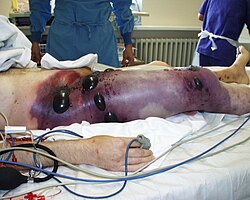Gangrene
Gangrene is a necrosis modified by secondary changes (drying, infection).
Types of gangrene[edit | edit source]

Dry gangrene (mummification)[edit | edit source]
Necrosis modified by desiccation (fysiologically – umbilical cord). It occurs mainly on the limbs during vascular occlusion. The breakdown of erythrocytes occurs.Hemoglobin changes to hematin (the color is first purple-red, later dark brown). Dry skin resembles parchment.
Wet gangrene sněť (sphacelus)[edit | edit source]
Necrosis modified by an infection by putrefactive bacteria (fusospirilla, genus Proteus etc.). It most often follows coagulation necrosis.
Necrotic tissue has a moist appearance, smells, and disintegrates in streaks. The color is dirty green. This coloration is due to the action of sulfane produced by the bacteria on the hemoglobin, which changes to green verdohemoglobin (as in pseudomelanosis). Percolation facilitates the penetration of decaying substances and bacterial toxins into the circulation, leading to fatal toxemia.
It primarily affects the lungs, intestines, tumours, feet of diabetics. Another example is fusospirillosis (synergistic action of Borrelia Vincenti and Fusobacterium fusiforme), which causes Plaut-Vincent's angina, ulceromembranous Gingivitis and noma (necrotic breakdown of the buccal mucosa in general collapse - especially in malnourished children in Africa). However, these diseases are rather classified as gangrenous inflammations (gangrene is a regressive change, not an inflammation).
Gas gangrene (gangraena emphysematosa)[edit | edit source]
Necrosis modified by infection by histotoxic gas-forming clostridia, eg Clostridium perfringens (Welchii). It occurs after trauma, when clostridia are embedded deep in the tissue (soil contamination in the wound), where they can multiply in an anaerobic environment.
With their toxins, they cause myonecrosis - the toxins penetrate into the circulation, the patient dies of toxemia. The alpha toxin is lecithinase - lipids can sometimes be detected in the blood. During their metabolism, clostridia convert glycogen into methane. The gas bubbles then penetrate the tissues, which crackle to the touch.
Macroscopically, edema, crepitation of gas during palpation, change in color - from dark redness, through dark bronze to black.
Gangrene and risk factors[edit | edit source]
- Diabetes mellitus;
- atherosclerosis;
- Bürger's disease (thrombangiitis obliterans);
- gangrene after a burn;
- Blood vessel spasm caused gangrene (Raynaud's disease);
- gangrene in decubitus;
- appendicitis gangraenosa (inflammation of the wall affecting the vessels – ischemie – gangrene of the wall with perforation develops).
Links[edit | edit source]
Related articles[edit | edit source]
Sources[edit | edit source]
- PASTOR, Jan. Langenbeck's medical web page [online]. [cit. 03.08.2009]. <https://langenbeck.webs.com/>.
Used literature[edit | edit source]
- POVÝŠIL, Ctibor – ŠTEINER, Ivo. Obecná patologie. 1. edition. Praha. 2011. 290 pp. ISBN 978-80-7262-773-8.



